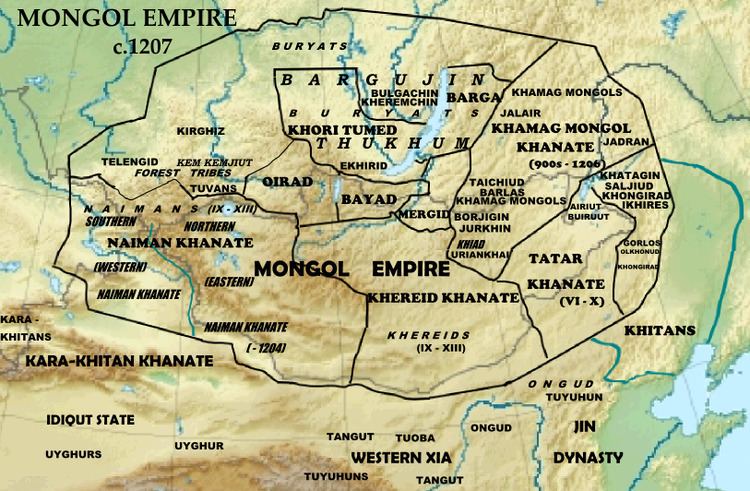 | ||
The Naiman (Khalkha-Mongolian: Найман/Naiman, "eight") is the name of a tribe originating in Mongolia.
Contents
History
In The Secret History of the Mongols, the Naiman subtribe the "Güchügüd" are mentioned. According to Russian Turkologist Nikolai Aristov's view, the Naiman Khanate's western border reached the Irtysh River and its eastern border reached the Mongolian Tamir River. The Altai Mountains and southern Altai Republic were part of the Naiman Khanate. They had diplomatic relations with the Kara-Khitans, and were subservient to them until 1177. Some scholars classified them as a Turkic people from Sekiz Oghuz (means "Eight Oghuz" in Turkic). Like the Khitans and the Uyghurs, many of them were Nestorian Christians or Buddhists. When the last Dayan Khan was killed after a battle with Genghis Khan in 1203, his son Kuchlug with his remaining Naiman troops fled to the Kara-Khitan Khanate. Kuchlug was well received there and the Khitan Khan gave him his daughter in marriage. Kuchlug soon began plotting against his new father-in-law, and after he usurped the throne, he began to persecute Muslims in the Hami Oases. But his action was opposed by local people and he was later defeated by the Mongols under Jebe.
Although the Naiman Khanlig was crushed by the Mongols, they were seen in every part of the Mongol Empire. Ogedei's great khatun ("queen") Töregene might have been from this tribe. Hulegu had a Naiman general, Ketbuqa, who died in the battle of Ain Jalut in 1260.
Modern Naimans
The modern Naiman tribe is a Mongol ethnic group in Naiman Banner, Inner Mongolia of China. The clan Naiman changed the clan name and mixed with other tribes in Mongolia.
Naiman Hazaras
There is a small population of Naimans in Afghanistan. They belong to the Hazara tribe and reside in the Sheikh Ali valley. They are Shia Muslims.
Among Turkic peoples
Modern Kazakh historians claim that more than 2 millions of the Kazakh population are Naimans (see Modern Kazakh tribes or Middle Juz). They originate from eastern Kazakhstan. Some Naimans dissimilated with the Kyrgyz and Uzbek ethnicities and are still found among them.Now, the Naimans are one of the big tribes of modern Kazakh peoples, they belong to Middle Juz of Kazakhs, live mainly in the eastern, central and southern parts of Kazakhstan, with a population of approximately 2 million among Kazakhs in Kazakhstan.
They also exist with considerable population among the Kazakhs in China, Uzbekistan and Russia, the Naiman tribe populations in the Kazakhs in China is one million or more, mostly living in the western part of Xinjiang Uighur Autonomous Region of China, in the Ili Kazakh Autonomous Prefecture. Naimans are also one of the major tribe among Kazakhs in the Uzbekistan, they also exist among Kazakhs in Kyrgyzstan and Russia.And, one of the interesting fact that in the Naiman Shejire (the history of Kazakh tribes) of Kazakhs, it is said that there is a sub-tribe of Naiman tribe of Kazakhs which called Khitan (Kitay or Qitay, Қытай in Kazakh language), this Khitan (Kitay) tribe of Naiman has considerable population among Naimans of Kazakhs, it is approximately estimated that 40% of Naimans of Kazakhs are from this Khitan sub-tribe of Naimans, many Naimans of Kazakh often and commonly trace back their clan roots to this Khitan sub-tribe of Naimans, The Khitan sub-tibe of Naimans branched as Karakerey, Matay, Sadyr and Dortuyl; some Kazakh historians considered this Khitan tribe of Naimans as the Kara Khitan people whose assimilated into Naimans after controlling of Kara Khitan Khanate by Kuchlug and later on during the conquest of Genghis Khan, it can be found many Shejires about Naimans in Kazakh litterateurs and poets. See Naimans introduction in Kazakh language, "Kazakh shezhire".The most recently Y-DNA tests which investigated by KZ DNA Project in Kazakhstan shows that the Y-DNA haplogroup of Naiman tribe of Kazakhs mostly carries O3 and some C, G, N haplogroups see KZ DNA Project.
Religion
The Naimans might have been Christians in the early 13th century. However, there is no archaeological evidence to support this claim.
They remained so after the Mongol conquest and were among the second wave of Christians to enter China with Kublai Khan. The Naimans who settled in the western khanates of the Mongol Empire all eventually converted to Islam. There was a tradition that the Naimans and their Christian relatives, the Keraites, descended from the Biblical Magi. The commander of the Mongol army that invaded Syria in 1259, Kitbuqa, was a Naiman: he is recorded to have "loved and honoured the Christians, because he was of the lineage of the Three Kings of Orient who came to Bethlehem to adore the nativity of Our Lord". However, Kitbuqa was slain and his army decisively defeated at the Battle of Ain Jalut, ensuring continued Muslim hegemony over the Levant. Southern Mongolian Naimans converted to Buddhism in the sixteenth century.
